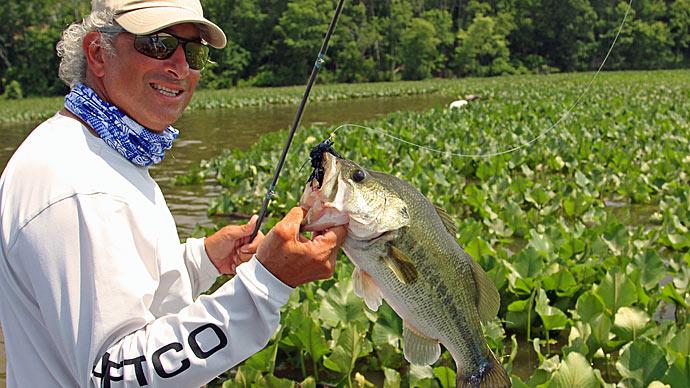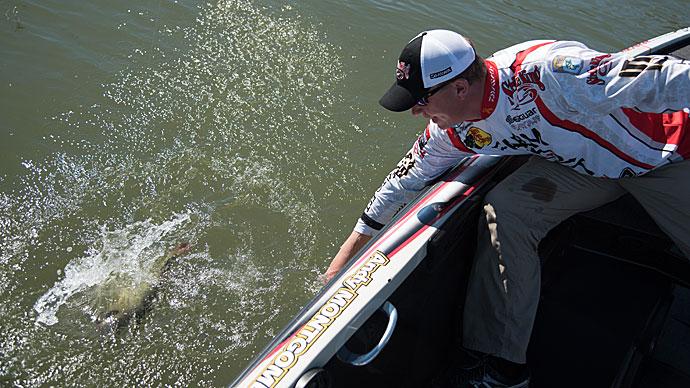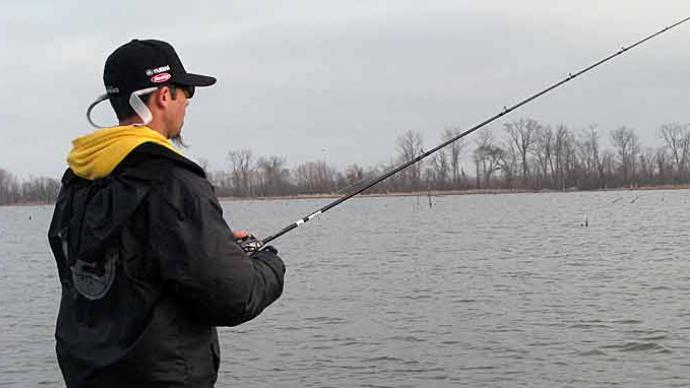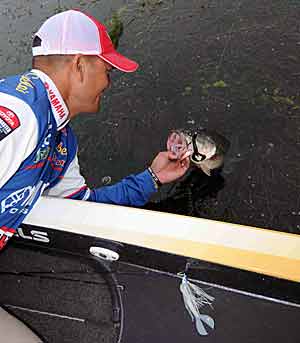
Matted aquatic vegetation is probably the easiest spot to find bass on any given lake, but it is also the most challenging cover to penetrate and haul out bass from their weedy hideouts.
“It is the ultimate (cover) option for bass,” says Bassmaster Elite Series pro James Niggemeyer. “Bass are a close-quarters combat fish. They are short-burst ambush feeders.” So the weeds present plenty of edges bass can use for ambush points, and the lush vegetation also draws all kinds of bass forage such as shad, bluegill, and crayfish.
Matted hydrilla is Niggemeyer’s favorite type of vegetation for flipping and pitching. “A lot of times when the fish get in the hydrilla, they can group up in large numbers, and they tend to be better quality fish,” Niggemeyer says. “You can catch five big ones in literally five flips.”
The Texas pro notes he can catch bass from the weeds year-round, but the best time to target bass in the hydrilla is from mid-summer throughout the fall. The grass is thicker then, allowing more bass to congregate under the mats. Matted vegetation also produces good action on Southern lakes during the prespawn and post-spawn periods.
Weather plays a crucial role in where bass position in the matted vegetation. Niggemeyer suggests if it is cloudy or windy, the fish will hold loosely on the edge of the weeds, where they are more susceptible to action lures such as spinnerbaits, crankbaits, and bladed jigs. Calm, sunny weather are Niggemeyer’s preferred conditions for flipping and pitching to bass congregating in the thickest part of the mats.
Openings in the mats, indentions, and any irregular features in the grass are ideal targets for flipping and pitching. However, Niggemeyer favors punching through the thickest part of the mat since other anglers tend to shy away from these spots and fish the holes in the grass.
The Texas angler penetrates the mats with a 3/4- to 1 1/4-ounce Strike King Hack Attack Jig. “There is not a jig that is more developed for fishing heavy cover and fishing in the grass,” Niggemeyer says. “It has a 30-degree line tie, so where you tie the line to almost comes out at the front of the jig, and it has more of a conical shaped nose, so it tends to go through cover well. Since the line tie is almost straight in front of the hook, it is like a Texas rig, giving me a much better hookup ratio.”
Niggemeyer also believes the heavy-duty hook on the Hack Attack Jig improves his chances of hooking a bass in the thick mats. “I like that because when I am flipping grass, I usually use a heavy flipping stick and braided line, so when I set the hook, there will be a give-point somewhere, but I don’t want the hook to flex,” he says. “I want it to be a direct pull, and I want the hook to penetrate so that heavy gauge hook allows me to do that.”
A Strike King Rage Craw is attached to the back of Niggemeyer’s jig. “It’s got a lot of action, but it also compresses well, so it gets through the weeds and doesn’t hang up like some of the other bulkier trailers,” Niggemeyer says. The Texas pro will use the Rage Craw or other soft plastics on a Texas rig if he wants to give bass a different look in weeds receiving heavy fishing pressure.
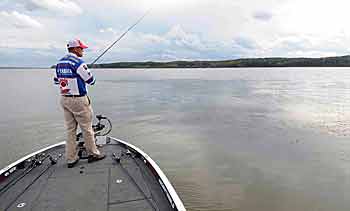
Niggemeyer opts for the longer 7-foot, 9-inch heavy-action St. Croix Legend Tournament Punchin’ Rod rather than the standard 7 1/2-foot flipping stick for his weed tactics. “I like that rod because when I am flipping weeds, I like to have a little bit more leverage (which the extra length gives him),” he says.
An Ardent Apex Pro baitcast reel with a 7.3:1 gear ratio is Niggemeyer’s choice for quickly reeling in line for the hookset. “Sometimes the fish will bite it and move right or left in the cover, and I don’t want the fish to use that as leverage against me, so the quicker I can turn the handle and take up slack to set the hook, it works out a lot better,” he says. “I can take more control over the fish faster than I would with a 6.3:1 or 6.5:1 gear ratio reel.”
His line of choice for pitching in the weeds is 50- to 65-pound test TUF-Line Domin8 braided line in a low visibility green. He prefers braided line in the weeds because it slices through the vegetation better than monofilament or fluorocarbon.
After his jig punches through the mat, Niggemeyer lets it fall quickly to the bottom. “I try to let that bait fall vertically uninhibited by my rod or reel or anything like that,” he says. “Once it gets to the bottom, I take up the slack and weigh it. I lift it to see if it feels like whatever size weight I am using at that time. I will work it up and down until I establish where the fish are located, whether high in the water column below the canopy of weeds or down on the bottom.”
Once he figures out how the fish want his jig presented, Niggemeyer will key on the weeds the rest of the day, trying to trigger five quality bites.
BassResource may receive a portion of revenues if you make a purchase using a link above.

